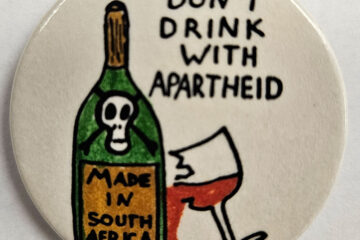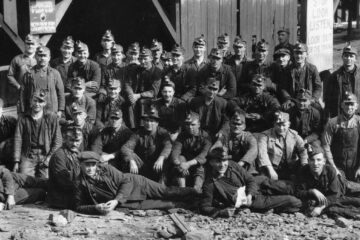The Tragic Death of Longshoreman Clarence Clemens
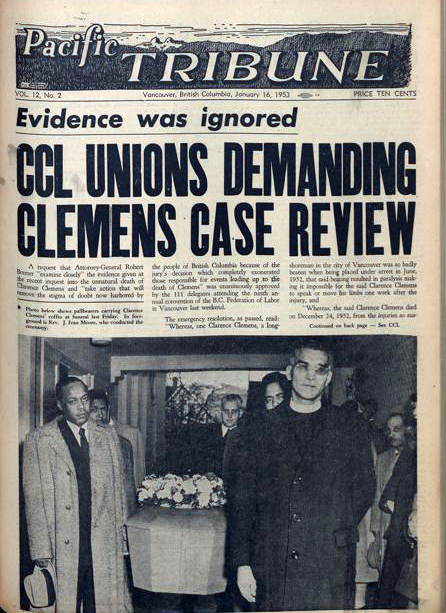
Pallbearers carrying Clarence Clemens’ coffin at his funeral in January 1953. In the foreground is Rev. J. Ivan Moore who conducted the ceremony. Pacific Tribune, January 16, 1953, 1.
Born January 27, 1900 in Alberta, Clarence Clemens moved to British Columbia from Edmonton sometime in 1937. He soon found work on the docks as a longshoreman employed by Empire Stevedoring Co. and settled into the predominantly black neighbourhood of Strathcona in East Vancouver. The heart of this community was known as Hogan’s Alley, and it was an exciting place: nightclubs, cabarets, bootlegging joints, and fried chicken restaurants filled the streets with music and life.
On August 8, 1952, the Pacific Tribune broke a shocking story with the headline: “Negro Held in Hospital; Beaten by City Cops.” The article went on to explain the details. “… a 52-year-old longshoreman, Clarence Clemens lies in a semi-paralysed condition… if he lives, he may never walk again.” Those closest to Clarence were less than shocked: “Talk to his friends, Negro and white, and they will tell you that the man responsible for his condition in General Hospital is a ‘Negro-hating cop’, Constable Dan Brown, one of the ‘guardians of the law’ who, according to all their reports, punched, pummelled and kicked Clemens into insensibility…”

Vancouver Sun, Jan. 6, 1953
Clemens was no stranger to run-ins with the police. He had recently been released from prison for a stabbing incident and had multiple charges on his record. But on July 19th, 1952, Clarence seemed to be minding his own business – waiting for his new common-law wife, Delores Dingman, at the New Station Café at 736 Main Street on the west side of Hogan’s Alley. New Station was open 24/7, and as such was well known for its drinking and loitering clientele. Customers would bring their own drinks and order food from the Chinese owners, talking for hours and dancing up and down the aisles. Clarence would have been unlikely to draw any attention having a few drinks while waiting here in the early morning hours.
Fighting the effects of his long, hard day at work on the docks combined with the alcohol, he laid his head on his arms and dozed while he waited for Delores to return.
The Arrest
According to the police, Clemens was drunk and loitering when they approached him, and he resisted arrest outside the café. After taking him to jail, he was charged with assault, and he began to complain of partial paralysis and severe pain later that morning. He was taken to the hospital for x-rays; with no visible fractures, he was diagnosed “hysteric”, taken back to jail and released on $50 bail paid by his wife.
Clarence’s condition declined rapidly at home, and he lapsed into a coma after a few days. He was readmitted to hospital with a fever of 109 degrees and never recovered. He passed away on Christmas Eve, December 24, 1952.
Unsurprisingly, mainstream media and the general public showed little interest in the case. The Vancouver Sun initially declined to report on the incident, and the Province only mentioned the beating in passing, with no reference to Clarence’s name or race. It was only the Communist press, the Pacific Tribune, that raised the profile of the case and made a public call for the Vancouver Joint Labor Committee to Combat Racial Discrimination to investigate the story. They printed a total of 38 articles on the case. Of course, some saw this as the local left-wingers trying to undermine faith and respect for the police and democracy at large. Constable Dan Brown sued the newspaper for defamation in their coverage of the case.
Calls for Justice
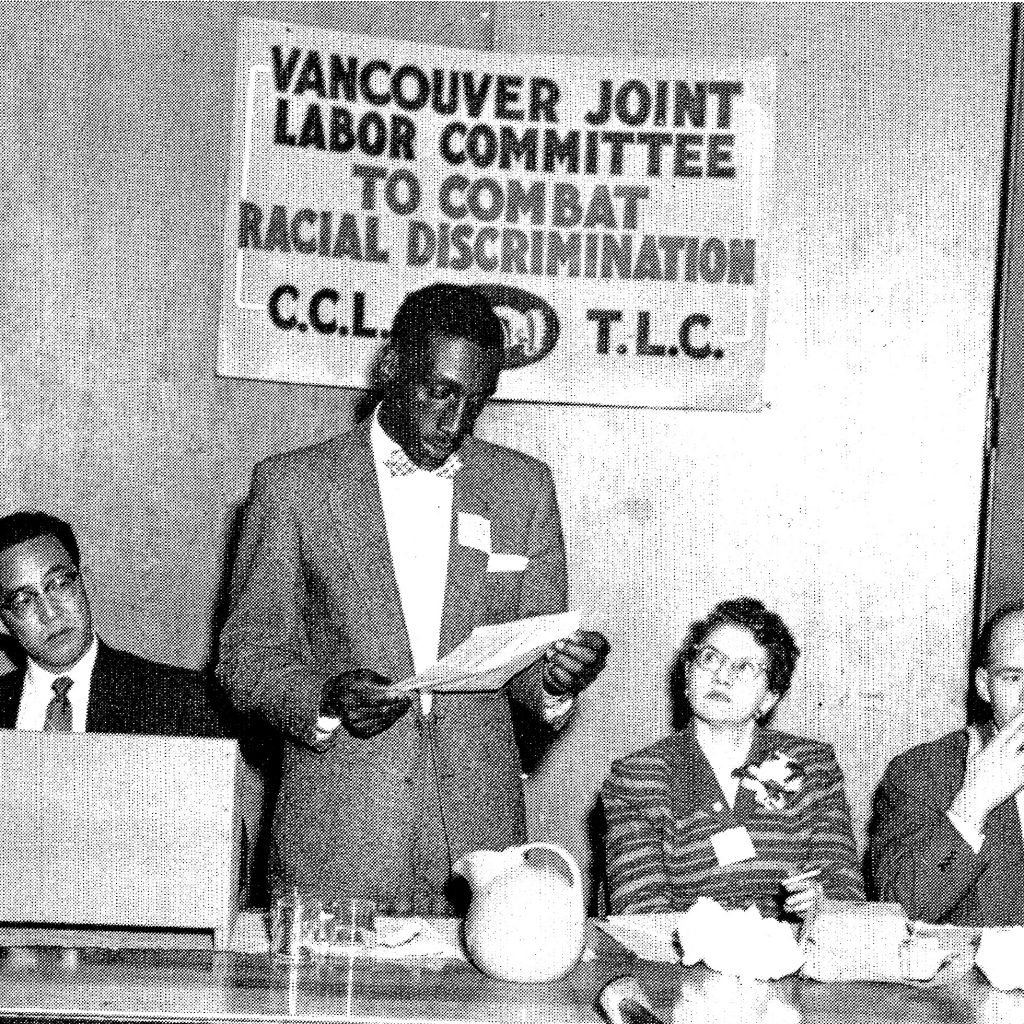
IWA union activist Emmitt Holmes stands in front of a banner reading “Vancouver Joint Labor Committee to Combat Racial Discrimination”. The labour community became involved in the calls for justice early in this case and continued to amplify the issue throughout the inquest. Patrick Kerr photo, courtesy of Allen Seager.
Up until that year, the committee had taken up some incidents of racism, such as claims by the Brotherhood of Sleeping Car Porters that blacks were being denied service in Vancouver beer parlours, but there were none serious enough to garner public outrage. The Clemens case became a sparkplug that activated the conversation around racism in Vancouver. The Marine Workers and Boilermakers Union passed a resolution demanding a public inquiry into the alleged beating, and sent a letter reading: “Our information is that Clemens was brutally set upon by the arresting policemen… We have heard of such conditions in fascist Germany and we won’t tolerate such conditions here.”
Frank Collins [of the United Brotherhood of Sleeping Car Porters] concluded that Clemens had been the victim of “a sadistic beating” by officers Brown and Wintrip. An investigation was opened, but with Clemens now unable to speak, the prosecutor declared a lack of evidence and dropped the charges.
The situation changed when Clarence died in hospital. His death was marked “unnatural” by the coroner – the Coroner’s Act mandated an inquest in this case.
The Inquest
The inquest began on January 6, 1953 with a packed courthouse; 250 spectators were turned away, despite demands for a larger room. 90 percent of the 84 who attended were Black, with several White spectators representing the human rights community. Despite the obvious intersection of class and race in this case, the jury consisted entirely of middle-class White males – and contrary to common practice, they had been selected from as far away as Burnaby.
Over 50 witnesses were called. The police testified that the scuffle lasted almost 10 minutes and continued even after Clemens had been placed in the “paddy wagon”. One officer admitted he hit him so hard that he injured his own hand. They claimed it was an appropriate use of force after Clarence went “absolutely berserk”; but according to another witness, they had handcuffed Clemens and beat him mercilessly with fists, boots and a truncheon. The Chinese-Canadian café staff denied having called for any assistance and didn’t recall any trouble. Clarence’s criminal history was also paraded through the court. John Stanton, the lawyer representing the Pacific Tribune, was overruled in his objection to this evidence. However, it was the testimony of medical professionals that would push the final decision.
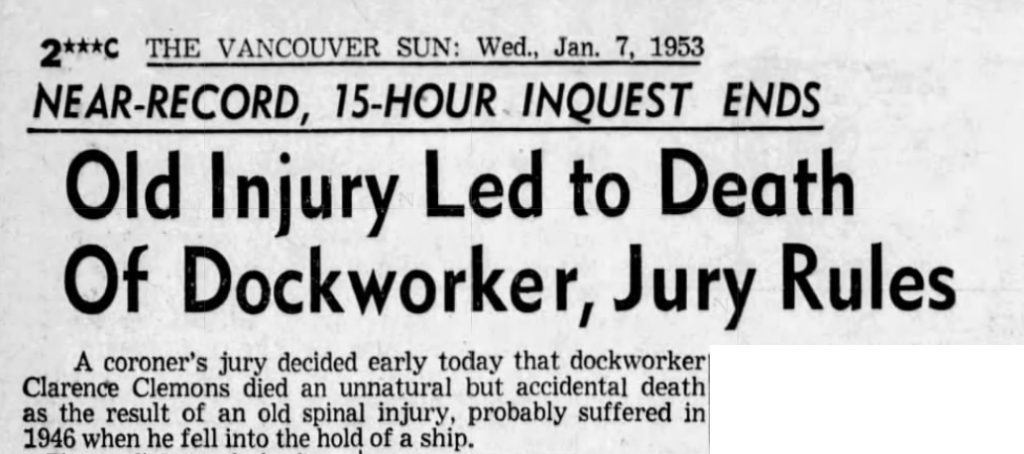
Vancouver Sun, Jan. 7, 1953.
The Verdict
All the medical experts called on agreed that Clemens had a previously existing osteoarthritic condition between his 3rd and 4th cervical vertebrae, near the base of his skull. The doctors repeatedly emphasized that this was typical for a shoreworker, or as one put it, among people “who do hard work”. These statements clearly “shifted the blame of Clemens’ death onto his own shoulders, or more specifically, onto his own spine” (Porth). Though none claimed with any certainty when exactly the spinal cord had swelled enough to cause injury, they maintained that his work as a longshoreman had left him so prone that even a minor scuffle could have done irreparable damage. After less than an hour deliberating, the jury ruled that Clarence Clemens had died “an unnatural death… caused by an old injury which may have been aggravated by his strenuous struggle while resisting arrest by two Vancouver City Police Officers…in the normal course of their duty.”
Immediately after the verdict was read, a “slim, middle-aged Negro” stood up and asked if he could ask a question and was shouted at by police to be quiet. “I’m not satisfied with this verdict and I want to ask a question.” The coroner threatened him to “sit down, or we’ll take you upstairs and let you ask your questions up there.” As officers moved closer, the man quickly sat down.
Vancouver’s Black Community Mobilizes
The Black community still had questions. On Monday, January 12, 1953, a group of more than 150 black Vancouverites met at the Fishermen’s Hall and created the Negro Citizen’s League (NCL). Its first act was to unanimously pass a resolution for the Attorney-General to investigate the inquiry verdict.
The B.C. Federation of Labor Convention unanimously endorsed a resolution decrying the jury’s decision “which completely exonerated those responsible for events leading up to the death of Clarence Clemens.” The Vancouver Labor Council (CCL) passed a similar resolution.
In an open letter to the Attorney-General, George North Editor of The Fisherman union newspaper said, “he sat through the entire proceedings of the inquest and came away from the court room shocked that any jury which had before it the evidence presented by some 52 witnesses could reach the conclusion it did.” (Pacific Tribune, January 16, 1953, 12.)
The Attorney-General procrastinated for months on a promise to examine the verdict, until the issue had cooled down and one of the police officers already resigned. He then declared “no useful purpose” would be served by investigating further.
The fact that his working-class status was invoked as his cause of death galvanized the labour movement in his defence. Tensions that had been simmering between police and the Black community bubbled over, and the issues of racism and police brutality were brought to the surface.
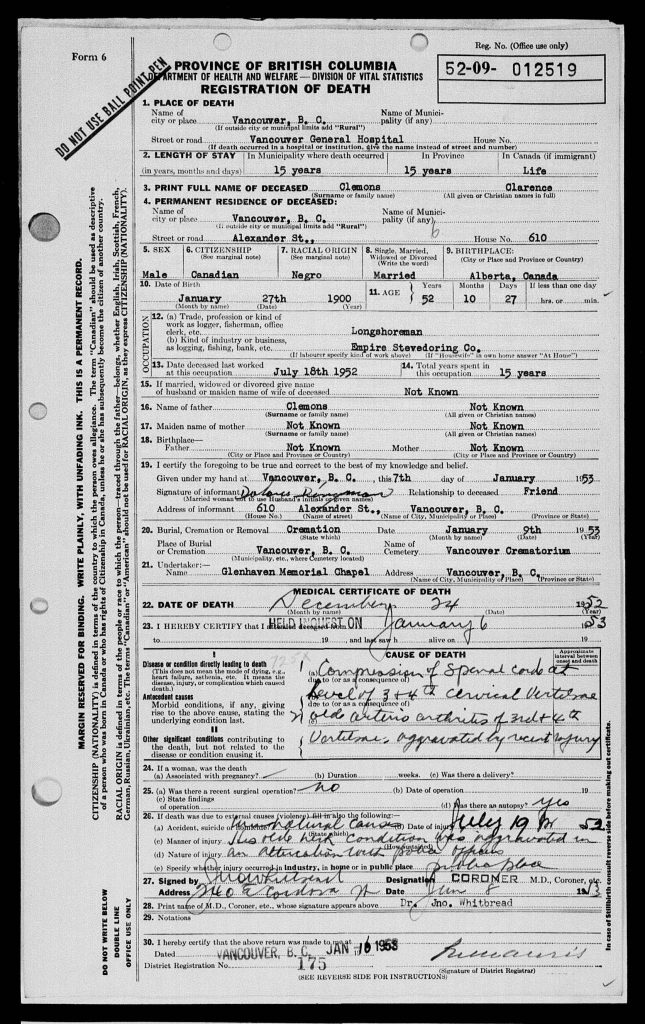
The 1952 death certificate of Clarence Clemons. (BC Archives)
During the time while he was still conscious at his apartment, Clemens told a friend that the officers had “knocked him down…. kicking him in the privates and all up and down his privates.” Some think this could possibly explain why doctors reported no bruising on his body. Emmitt Holmes later recalled that one of the officers was particularly hostile to Clemens because his wife Delores was White. “It is not difficult to hypothesize, therefore, that the two police officers were looking for an excuse to vent their spleen upon a man who symbolized the worst fears of White racists.” (Lambertson)
The NCL faded away, but the BC Association for the Advancement of Coloured Peoples (BCAACP) soon took its place in 1956. One of the founding members was union activist Emmitt Holmes, the only black member of the IWA when he joined in 1944, who had attended the Clemons inquiry himself. Union activist Frank Collins became an obvious choice for President and continued the fight against racism well into the 1970s.
Sources:
Lambertson, Ross. The Black, Brown, White and Red Blues: The Beating of Clarence Clemons. The Canadian Historical Review 85, 4. University of Toronto Press Incorporated, Dec. 2004. https://doi.org/10.3138/CHR.85.4.755
Porth, Ryan Burnard. Why Clarence Clemons Died: Power, Narrative, and the Death of a “Negro Longshoreman” in Vancouver, 1952-53. The University of British Columbia. Aug. 2003. https://dx.doi.org/10.14288/1.0091283
Rudder, Adam Julian. A Black Community in Vancouver?: A History of Invisibility. University of Victoria. 2004. Retrieved online January 2020.
